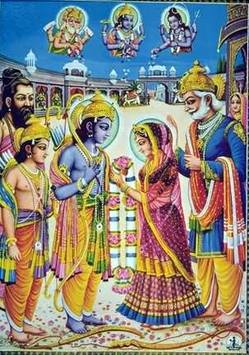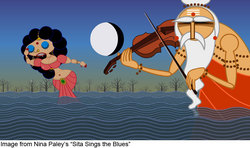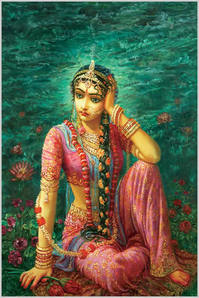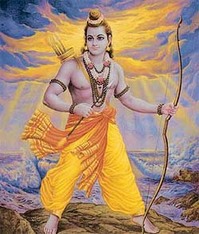 Many Hindus consider Lord Rama and his wife Sita Devi to be incarnations of the Divine in
Many Hindus consider Lord Rama and his wife Sita Devi to be incarnations of the Divine in
personal form, the God and Goddess that together constitute the
Supreme. In my blog post yesterday — based on a reflection that I shared at Princeton University’s Diwali celebration a few days ago — I described how the Ramayana is largely the story of reuniting Rama and Sita.
And that is precisely why the end of the Ramayana is so difficult to swallow.
Diwali celebrates the part of the story where Rama defeats Ravana, rescues his beloved Sita, and returns to rule over Ayodhya. Basically, the rest of the story goes like this: One day, years after Rama and Sita are happily living in Ayodhya, Rama hears a washerman doubting Sita’s faithfulness to Rama during her captivity in Lanka. Ostensibly to uphold dharma at any personal cost, Rama banishes Sita from the kingdom.
Say what? After pining for her, practically going mad missing her, and waging a war to free her, Rama sends Sita away? Why would Rama, glorified as the very personification of righteousness, behave so apparently cruelly and unreasonably?
Hindu scholars and practitioners have struggled with this. Some have
tried to present it in entirely metaphoric terms. Some have argued that
Rama’s banishing Sita was a mistake, proof of his own fallibility as a
human rather than a God. And still others maintain that Sita’s
banishment isn’t a legitimate part of the Ramayana at all.
 Another
Another
response has been to re-cast the Ramayana with focus on Sita as tragic
heroine. Examples of this include Nina Paley’s acclaimed (and cheeky)
animated short “Sita Sings the Blues“, and Hindu community leader Anju
Bhargava’s Sitayanam.
 Thanks to my friends at The Bhakti Collective, I came across this
Thanks to my friends at The Bhakti Collective, I came across this
explanation of Sita’s banishment, from the Bhakti perspective, given by
Radhanath Swami (who readers may also remember from this recent quote
featured on Chetan Bhagat’s blog). I find Radhanath Swami’s explanation
to be sensitive, deep, and spiritually insightful. Its esoteric to be sure,
and I’m not sure that everyone will be satisfied interpreting the
problematic ending to the Ramayana in this way, but I do think that it
gives us new appreciation for exploring the inner dimension of sacred
texts.
Here’s an excerpt:
“Vipralambha means separation, and separation intensifies
the experience of love. Just like in music, compare how many songs
there are about being happy together to the number of songs about
having a broken heart. Which are there more of? Why is it that there
are so many songs about the pain of separation? Because music is an
art, and art is an expression, and the expression of love in separation
is a very deep absorption. When somebody is with us we are absorbed in
a certain way, but when our loved one is away it increases our
remembrance, thoughts and absorption in that person. It is true that
when ones beloved is away one is always thinking of their beloved and
searching for them. When Rama was with Sita he was seeing her in one
place. But when Rama was away from Sita and Sita was away from Rama he
would see Sita in the trees and she would see Rama in the clouds,
everywhere. When we are together the love of our heart goes out towards
the beloved. In separation that love goes deeper and deeper and deeper
into the very core of our heart. And it is intensified. On the
spiritual platform love is not determined by our physical proximity.
Our connection to God or Rama is to the degree that we are internally
absorbed in the thought of Rama. And when our love is intense, the
Lord accepts it from within our heart. That love may be intense when
the Lord stands before us, but it is even more intense when the Lord is
not standing before us. When there is that longing, that deep deep
absorption, then the Lord is embracing us and reciprocating with us
from within.“So Sita is God. We have to understand the philosophical principle that according to Vedic sidhanta (conclusion) God is both female and male equally. There is the sakti (energy) and the saktiman
(energetic source). God’s female aspect as Laxmi, Sita, Radha, or
Parvati is the compassionate side of God. Krishna, Rama, Narayana, and
Shiva are very powerful, lordly manifestations of God. The feminine
aspect of God is the reservoir of love. And the masculine side of God
is the ultimate object of love. And those two aspects together are
God. Perhaps in western religion, because there is so much emphasis on
the masculine side of God, religious people can sometimes become very
egoistic and attached to power and control. They can lose their
compassionate essence.“So this is the one God. God is never separate. Sita and Rama can never be separate in essence. In their lila in this world they lived together and enjoyed love in union. But Rama
wanted to experience for himself, as well as have Sita experience, that
even deeper, intensified experience of love in separation. In their
hearts of hearts they could never be separated. So therefore Rama
banished Sita, but really he was blessing her by giving her a higher
experience of internal union and he also experienced that union. So the
great devotees of Rama, the great yogis, they understand it in this
way.“This banishment of Sita, amongst people who have gone deep into the
subject, is a very profound meditation on the loving exchange between
her and Rama. This conclusion that I am speaking has been passed down
for millennia. And how God and Goddess, male and female aspects, how
they shared the ecstasy of love for each other is not limited by our
ability to comprehend it. This is what they choose to do and we
understand that is what they really want to do. They go through the
whole lila in such a way that is very traumatic and brings about such emotions in all of us.”
(source: The Bhakti Collective. Read the whole essay here.)
As one Bhakti Collective reader commented, it’s both “counter intuitive” and “lovely.” For now, that will have to do.
“There is more love in separation than in union, for in
union the beloved is found in one place only, while in separation the
beloved is found everywhere.”
– Braja poet Nanda das


